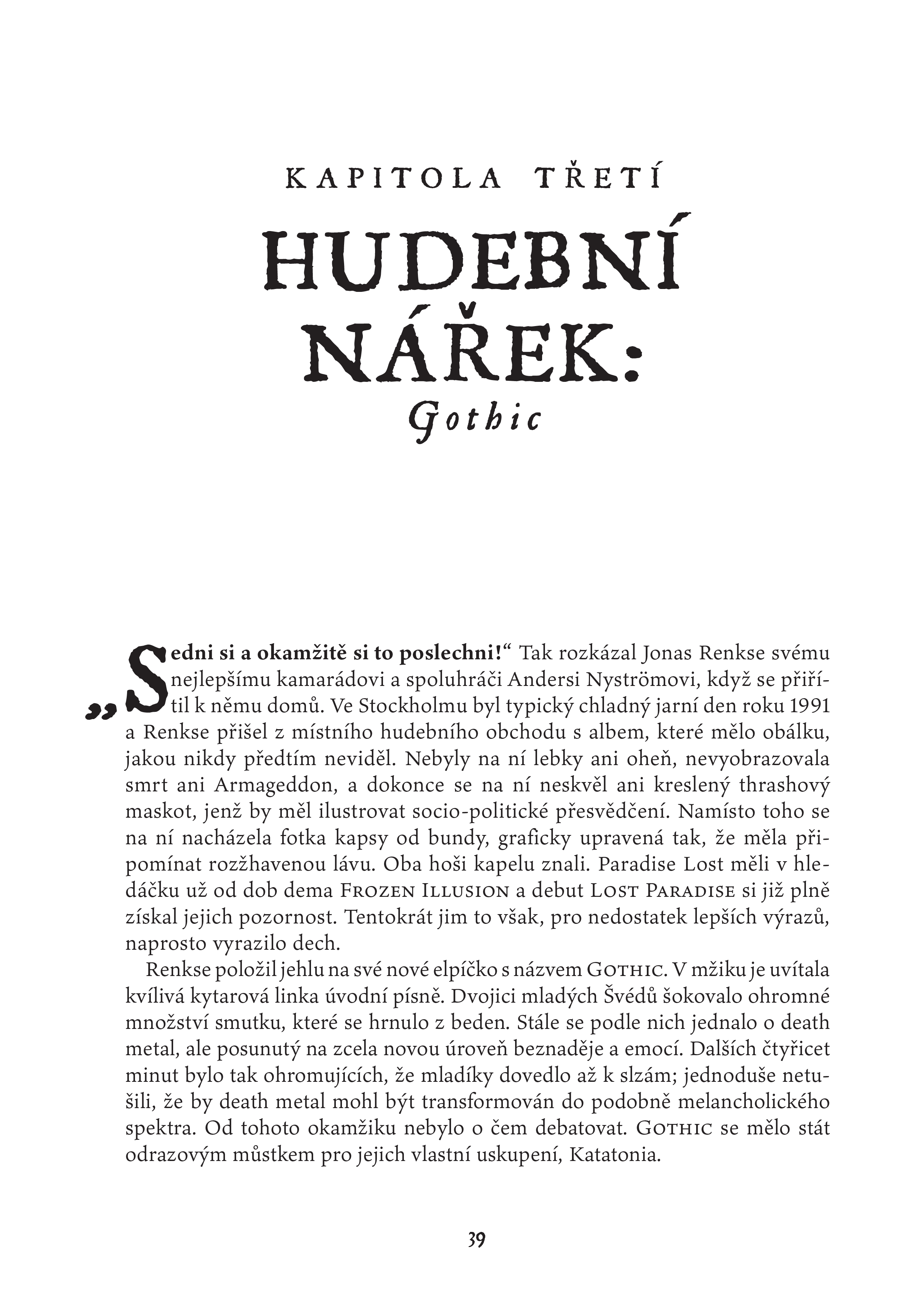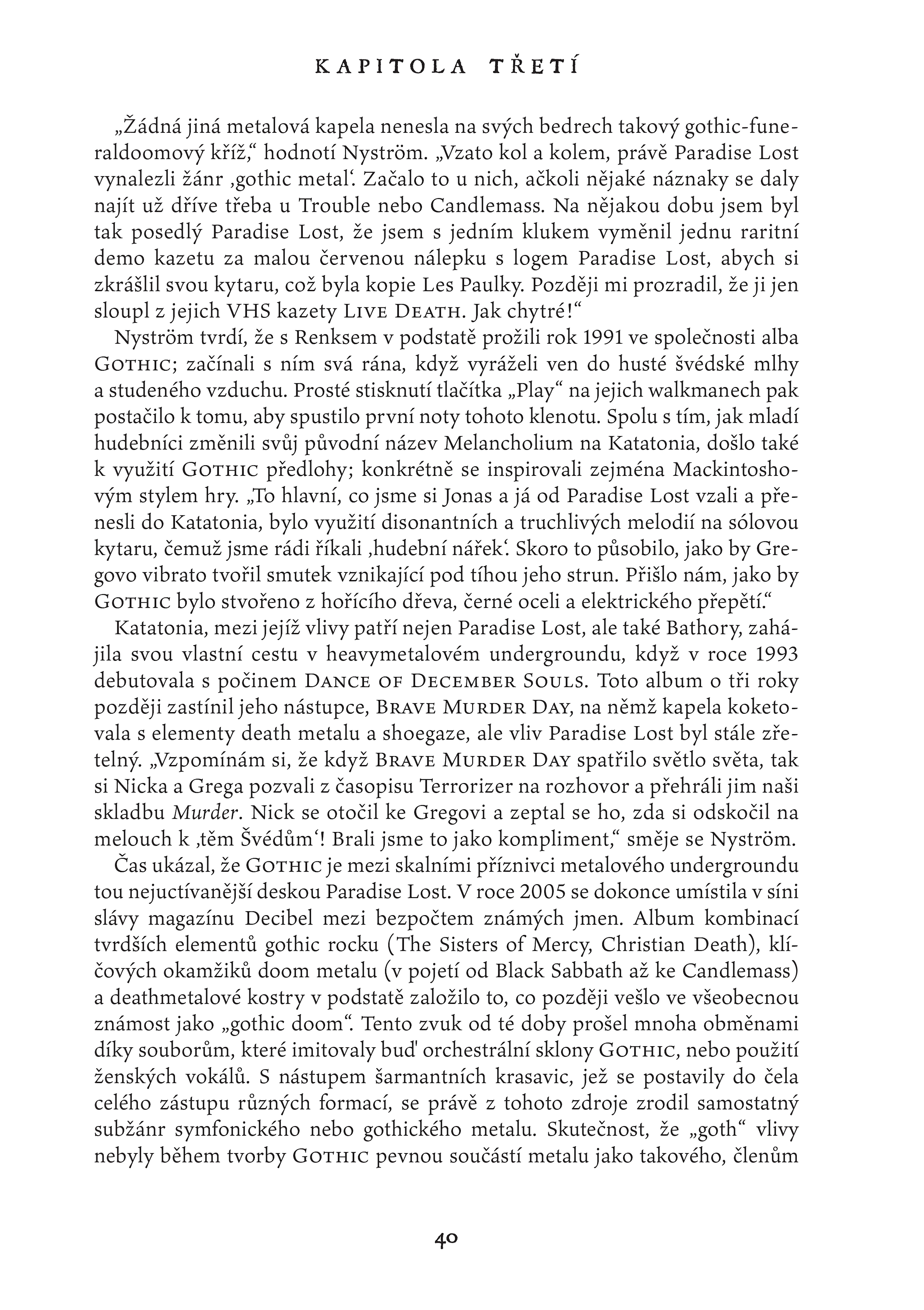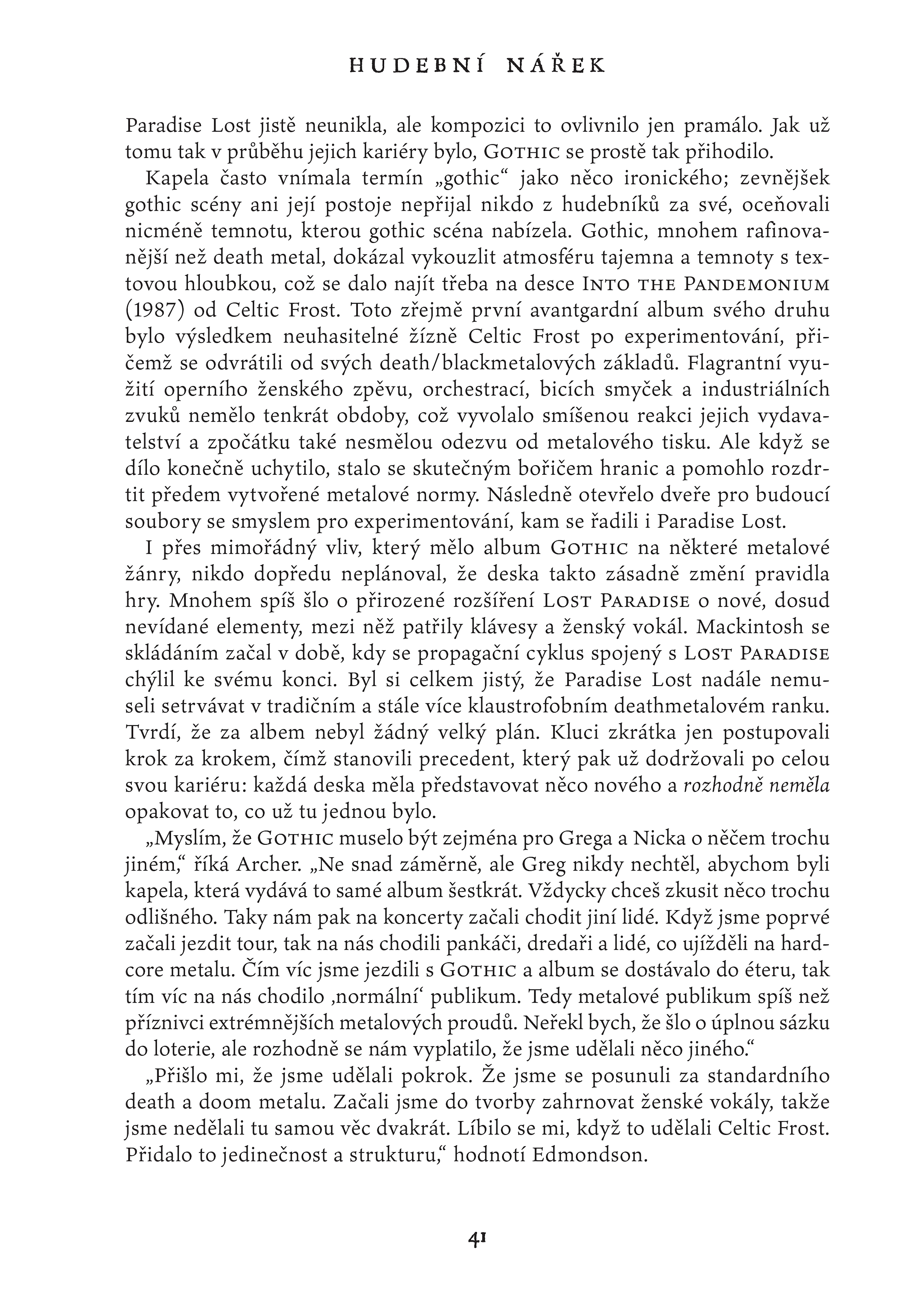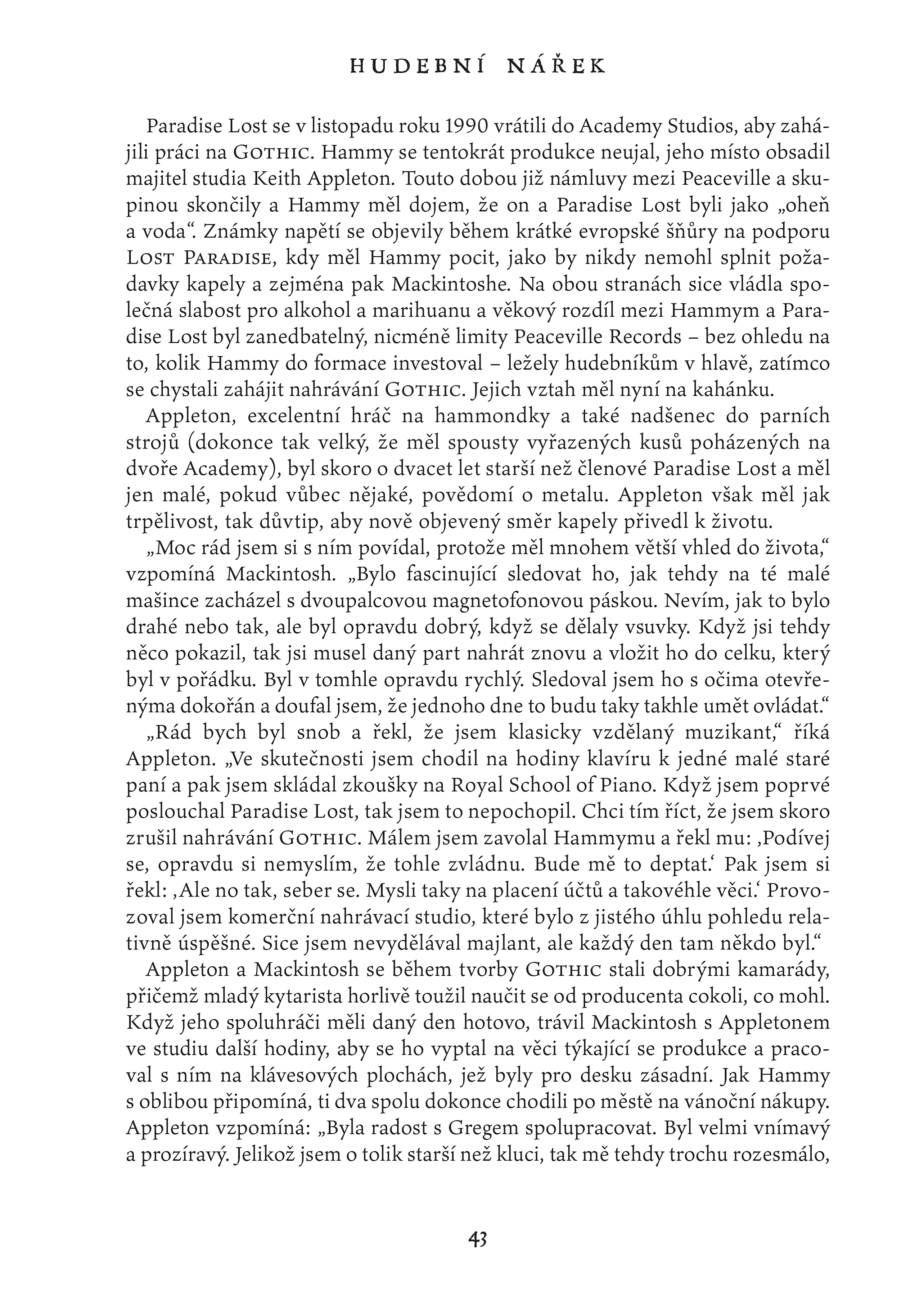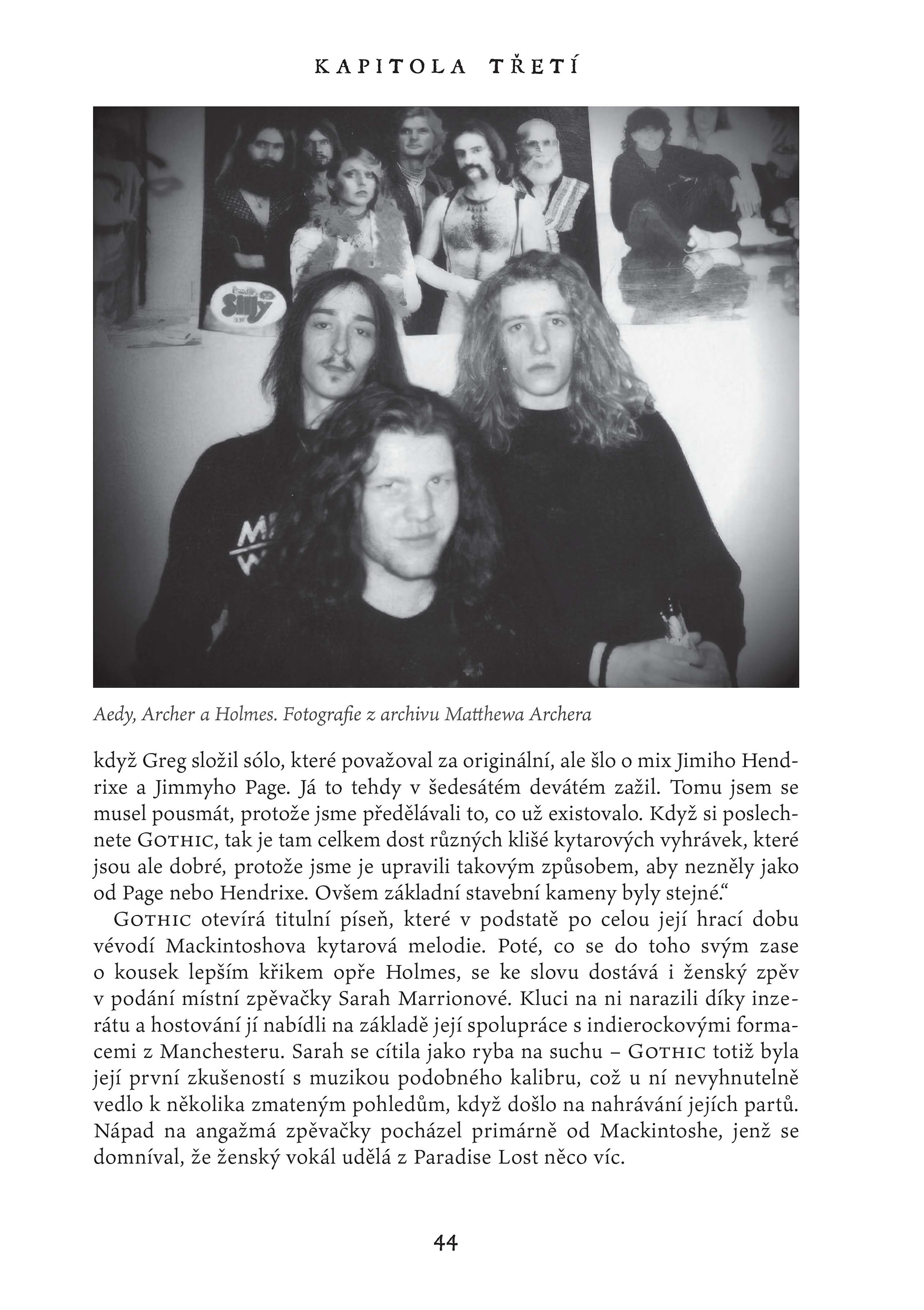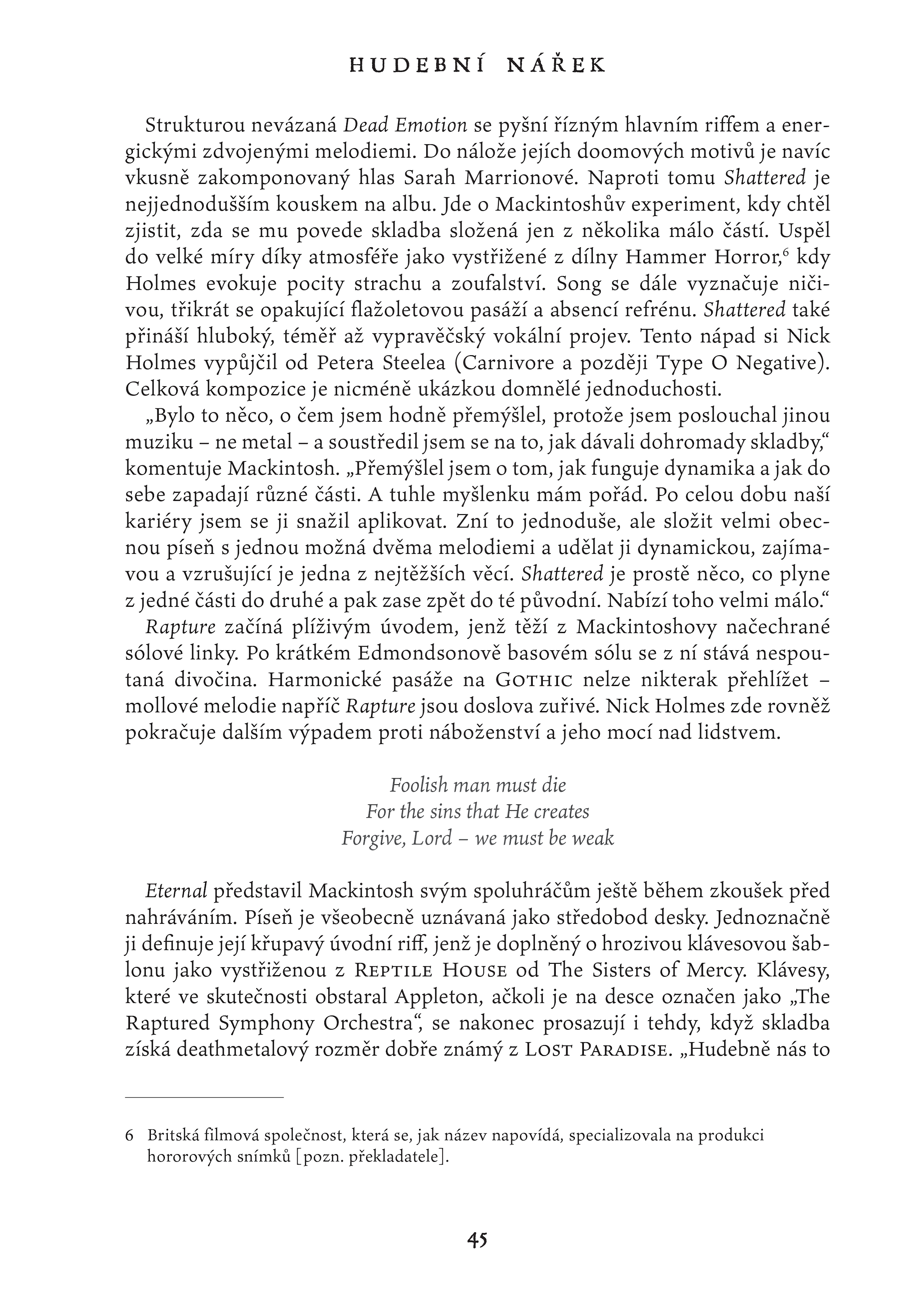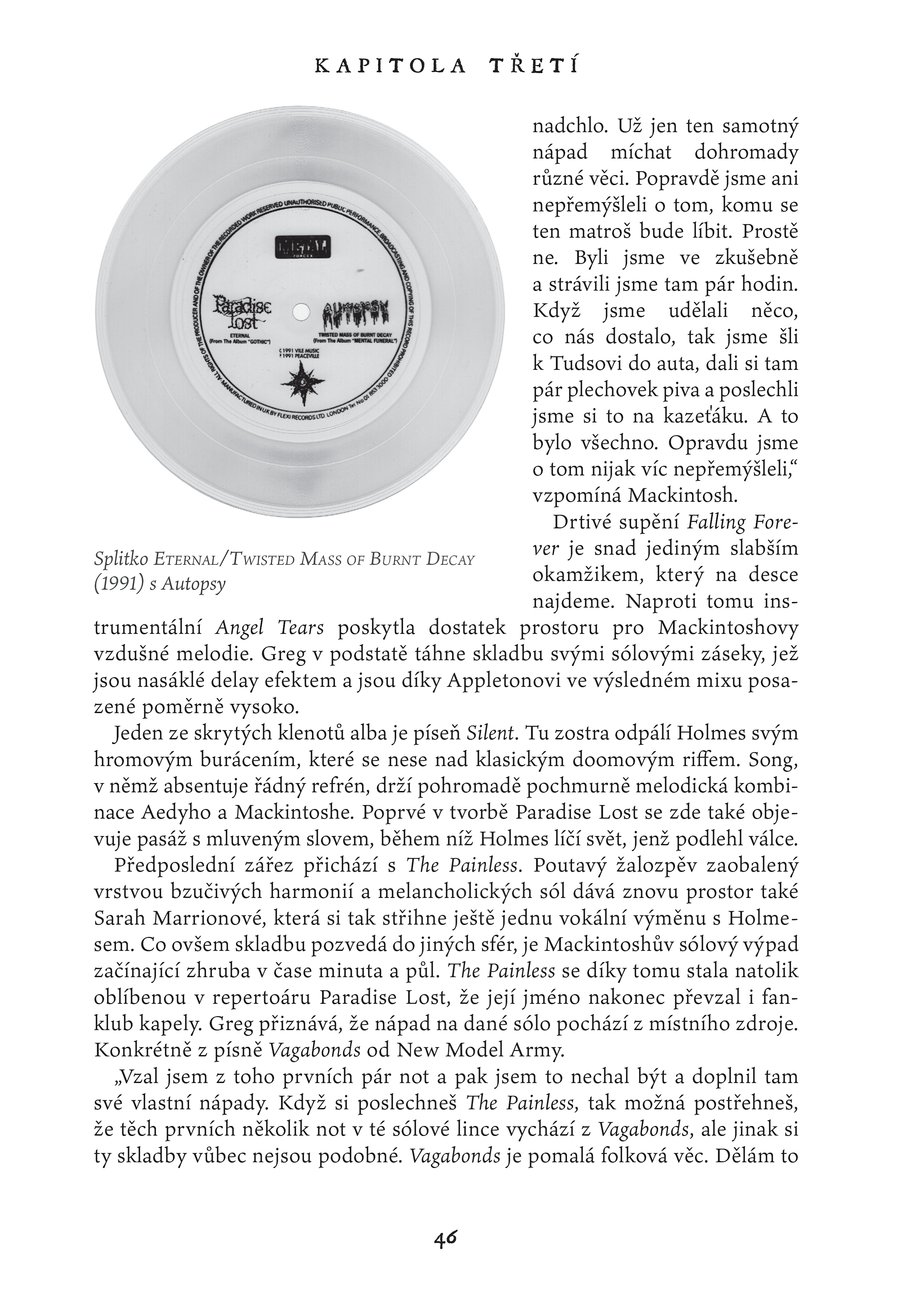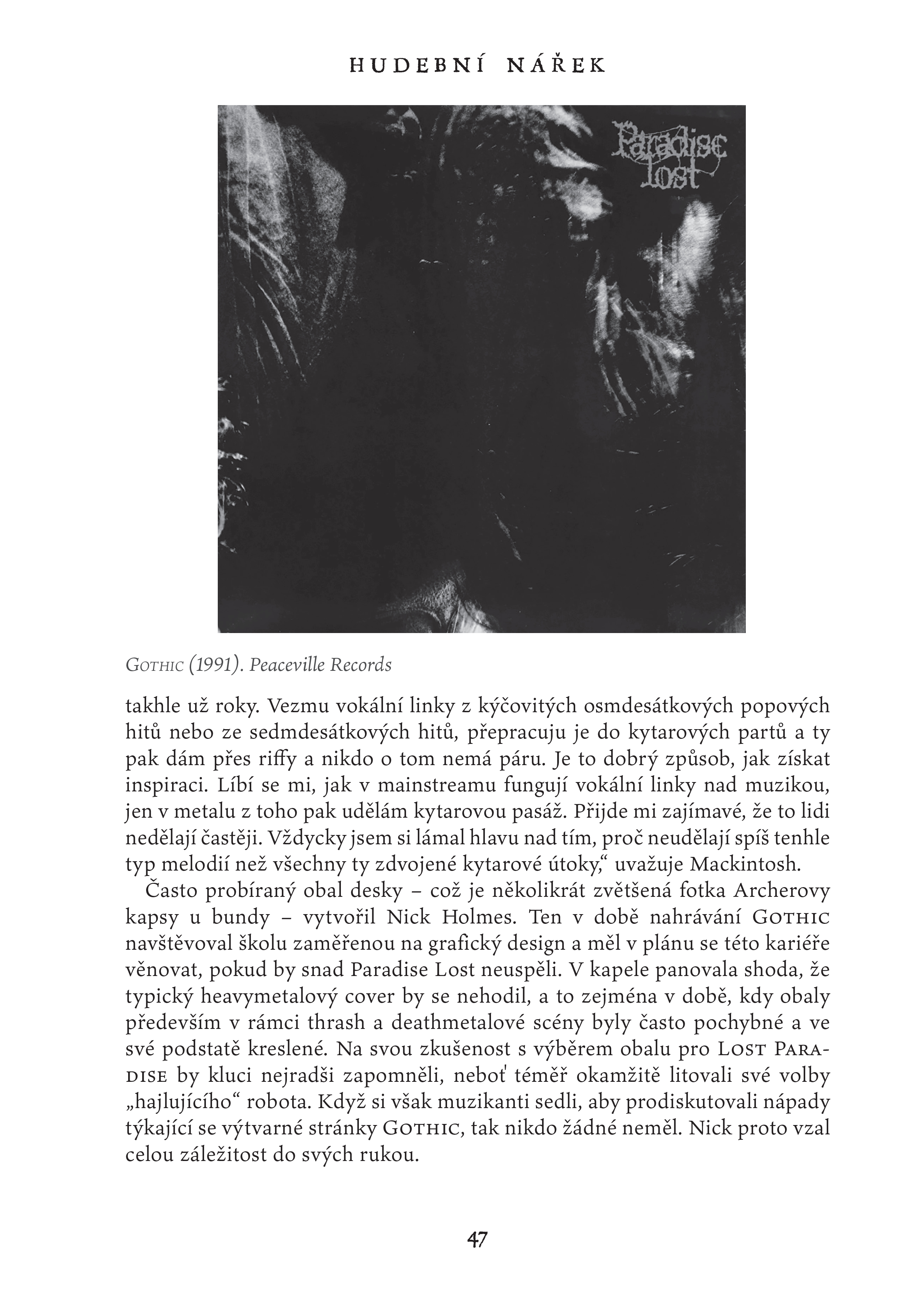Dear friends, herein comes the fourth installment of our coverage regarding the Czech translation of the book "No Celebration", that is, the official biography of the British gothic/doom metal legend Paradise Lost, by the American writer David E. Gehlke. Last time we, among other things, considered in more detail the contents of the book; today, we are following up on this subject with an excerpt!
In particular, the sample in question comes from chapter 3 of the book, which focuses on the band's breakthrough album "Gothic" from 1991.
As usual, the whole excerpt is presented as it will appear in the Czech translation when printed. The layout and typesetting is by Radek Doleží (the court visual artist of Forgotten Silence). Click on the individual images to zoom.
The English original text is as follows:
Musical Weeping: Gothic
“You need to sit down and hear this right now,” was the edict from Jonas Renkse to his best friend and bandmate, Anders Nyström, as the latter strode into his house. It was a typical cold spring day in Stockholm in 1991, and Renkse had returned home from his local record store with an album that had a cover unlike anything he’d seen before. It didn’t have skulls or death or fire or Armageddon or a cartoon thrash mascot trying to portray a socio-political bent. Instead, it featured a superimposed coat jacket pocket that was intended to resemble molten lava. Both knew of the band: Paradise Lost was already on their radar as far back as the Frozen Illusion demo, and Lost Paradise had previously captured the Swedes’ attention. But this time, their teenage minds, for a lack of a better term, were about to be blown.
Renkse proceeded to drop the needle on Gothic. Greeted instantly by a howling, dungeon-cradled lead guitar line on the opening title track, the two were taken aback by the abundance of sorrow spilling from their speakers. To them, it was still death metal but taken to a new level of despair and emotion. So overwhelming was the next 40 minutes that the two were brought to tears, simply unaware that death metal could be mutated into such a spectrum of melancholy. From that point on, there was no debate: Gothic was to be the launch point for their new band, Katatonia.
“No other band carried such a gothic doomy funeral cross on their shoulders within metal,” says Nyström. “After all, Paradise Lost invented the genre ‘gothic metal.’ It started with them, although you could see some sort of that indication in bands like Trouble and Candlemass earlier as well. For a while, I was so obsessed with PL that I ended up trading away a rare demo tape for a little red PL logo sticker to grace my Les Paul clone guitar. Later, the guy I traded it with told me he had just peeled it off the surface on their Live Death VHS tape. Smart!”
“No other band carried such a gothic doomy funeral cross on their shoulders within metal,” says Nyström. “After all, Paradise Lost invented the genre ‘gothic metal.’ It started with them, although you could see some sort of that indication in bands like Trouble and Candlemass earlier as well. For a while, I was so obsessed with PL that I ended up trading away a rare demo tape for a little red PL logo sticker to grace my Les Paul clone guitar. Later, the guy I traded it with told me he had just peeled it off the surface on their Live Death VHS tape. Smart!”
Nyström says he and Renkse essentially lived with Gothic throughout 1991, starting their mornings with it as they ventured outside in the dense Swedish fog and cold air, whereupon the simple push of “play” on their Walkman would usher in the album’s first notes. As the two made the steady transition from their original moniker of Melancholium to Katatonia, Gothic was used as the template; in particular, Mackintosh’s guitar playing. “What Jonas and I mostly took from Paradise Lost and brought to Katatonia was the use of dissonant and sorrowful lead guitar melodies, ‘musical weeping’ as we liked to call it. It almost seemed like Greg’s vibrato was generated by sorrow rotating the gravity of the string. To us, it felt like Gothic was made of burning wood, black steel and an overload of electricity.”
Katatonia, under the influence of not only Paradise Lost but Bathory as well, soon proceeded to embark on their own journey in the heavy metal underground, starting with their 1993 debut, Dance of December Souls. That album was eclipsed three years later by Brave Murder Day, which found the band dabbling in elements of death metal and shoegaze, but still with a pronounced Paradise Lost influence. “I remember Terrorizer magazine played them ‘Murder’ from Brave Murder Day when it came out, and Nick had turned to Greg asking if he’d been moonlighting with Swedes! We took that as a compliment,” laughs Nyström.
Time has shown that Gothic is the most revered Paradise Lost album among metal underground purists, earning a spot in Decibel’s Hall of Fame in 2005 among countless name-drops and artistic references. The album established what would be known as the “gothic doom” sound, the pairing of harder elements of gothic rock (the Sisters of Mercy, Christian Death) and the core tenants of doom stretched from Sabbath on through Candlemass with a death metal backbone. Since then, the sound has gone through multiple permutations with bands imitating Gothic’s orchestral leanings and use of female vocals, the latter becoming a sub-genre onto itself with the onset of buxom beauties fronting symphonic or goth metal bands. The fact “goth” was not a hard and firm thing within metal during the creation of Gothic certainly wasn’t lost on the members of Paradise Lost, but it had little to do with the album’s overall composition. As has been the case throughout their career, Gothic just happened.
The band often saw the “gothic” term as something tongue-in-cheek; none of them appropriated the scene’s looks or attitude but appreciated the darkness goth had to offer. Far subtler than death metal, goth conjured an air of mystery and darkness with lyrical depth, something that was found in Celtic Frost’s 1987 Into the Pandemonium. Arguably the first avant-garde album of its kind, Into the Pandemonium was the result of Celtic Frost’s unquenchable thirst for experimentation heading off their death and black metal origins. The flagrant use of operatic female vocals, orchestration, drum loops and industrial sounds had no equal at the time, eliciting puzzled reactions from the band’s label and a tentative initial response from the metal press. But when it did finally catch on, it was a true barrier-breaker, helping shatter preconceived norms about metal and then opening the door for future bands with a taste for experimentation, of which Paradise Lost was one.
Contrary to its exceeding influence within certain realms of metal, Gothic wasn’t originally hatched as the grandiose game-changer it became. Rather, it was simply the natural extension of Lost Paradise, just with the introduction of new, as-yet-seen elements such as keyboards and female vocals. Mackintosh started composing for the album when the Lost Paradise cycle was winding down, quite sure that the band no longer needed to be camped out in the traditional and increasingly claustrophobic death metal scene. There was no grand plan behind the album, he claims. They were simply going from one thing to the next, although it set a precedent Paradise Lost would follow for the rest of their career: Each album was to represent something new and definitely not be a repeat of what came before.
“I think Gothic, especially from Greg and Nick’s point of view, I think it had to be something a little bit different,” says Archer. “Not deliberately, but Greg always wanted to not be a band where we released the same album six times. You always want to try something a little bit different. We started getting different people at gigs. When we first started touring, we got punks, people with dreadlocks and all kinds of people that are into hardcore metal. The more we toured Gothic and the album was getting airplay, we got a more ‘normal’ audience. A metal audience rather than people who were into the more extreme sides of metal. I think it wasn’t really a gamble that we took, but it certainly paid off by doing something different.”
“I thought the band had progressed,” says Edmondson. “I thought we had progressed beyond what was your standard death and doom metal. We started incorporating female vocals, so we’re not making the same album twice. I liked when Celtic Frost did it — it added uniqueness and texture.”
“It’s not a massive umbrella within the music style that we do,” adds Holmes. “You’re using heavy guitars and drums so it’s only going to be so different. Especially with Gothic because it was very different than the first album. You can link all our albums to the same people that have written them. I think it’s a good attitude to go into a writing scenario like that, but ultimately, it’s the same people writing so you’re going to have similarities anyway. It’s like starting a new chapter, a psychological fresh page, I suppose. You’d never want to repeat the last album. I must admit I never say, ‘Oh shit, I want to do what we did the last time.’ To me, that’s like, ‘Oh, god, no.’ A lot of bands, particularly death metal bands, they do the same album every time and I just don’t understand their mentality. I don’t mean one or two albums. People with 30-year careers are still doing the same album.”
The band was sent back to Academy Studios in November 1990 to begin work on Gothic. Instead of Hammy manning the production board, this time it was studio owner Keith Appleton. By then, the honeymoon between Peaceville and the band was over, with Hammy of the belief that he and Paradise Lost were like “oil and water.” Signs of strain popped up during the band’s quick trek into Europe in support of Lost Paradise, with Hammy feeling as though he could never satisfy the band, especially Mackintosh. The two parties may have shared the same fondness for alcohol and marijuana and were only a few years apart in age, but the limitations of Peaceville Records — no matter how much Hammy invested into the band — was generally top of mind within the Paradise Lost ranks as they headed into the recording of Gothic. Their relationship was now simply living on borrowed time.
Appleton, not only an excellent Hammond organ player but also a steam engine aficionado to the point where discarded engines could be found scattered throughout Academy’s backyard, was nearly two decades older than the members of Paradise Lost and was without much, if any, knowledge of metal. What Appleton did have was both the patience and studio acumen to make the band’s new-found direction come to life.
“I used to love talking to him because it was like talking to someone who had much more insight into life,” says Mackintosh. “Watching him handle the two-inch tape back then on this little machine — I don’t know how expensive it was or what, but he was really good at doing drop-ins. If you’d messed something up, then you have to drop a part in. He was really fast on this machine. I remember being wide-eyed watching him do this thing and I thought, ‘Wow, I hope one day I can do that kind of stuff.’”
“I’d like to be snobby and say I’m a classically-trained musician,” says Appleton. “In reality, I took piano lessons from a little old lady and took the Royal School of Piano exams. Initially, when I first listened to Paradise Lost, I didn’t get it. I mean, I nearly canceled Gothic. I nearly rang Hammy and said, ‘Look, I really don’t think I can do this. It’s going to do my head in.’ I thought, ‘Come on, get a grip. Think of paying the bills and stuff like that.’ It was because I was running a commercial recording studio that was relatively successful from a point of view. I wasn’t making a fortune, but there was someone in every day.”
Appleton and Mackintosh formed a strong bond during the creation of Gothic, with the young guitarist eager to learn anything he could from the producer. When the rest of the band completed their parts for the day, Mackintosh would often stay extra hours at the studio with Appleton to pick his brain on production and work with him on the album’s crucial keyboard parts. The two — as Hammy fondly recalls — could be seen around town doing their Christmas shopping as well. “Greg was a joy to work with,” says Appleton. “He was very sensitive, very astute. What made me smile at the time was, because I was much older than the band, Greg would put a solo down that he thought was original and it was a cross between Jimi Hendrix and Jimmy Page. I was there in ’69 if you know what I’m talking about. That made me smile because we were revamping what was already there. If you listen to Gothic, there are quite a lot of cliché guitar licks on there that are good because we altered them in such a way that they didn’t sound like Page or Hendrix, but the basic building blocks were the same in relation to the scales he used.”
Gothic opens with the title track, a number led by Mackintosh’s guitar melody that virtually hangs in the air throughout. After Holmes digs in with his developing roar, female vocals courtesy of local singer Sarah Marrion enter the fray. Marrion was found through an ad placed in NME and fit the bill because of her work with indie rock bands in Manchester. The band recalls Marrion being the proverbial fish out of water — Gothic was her first exposure to music of this kind, eliciting the obligatory puzzled looks on the vocalist’s face when it came time to record her parts. The idea to bring Marrion in was primarily Mackintosh’s, who thought at the time that female vocals would make Paradise Lost more than just a band with gruff vocals.
“Dead Emotion,” with its chopping main riff and dashing twin melodies is unbound by structure, working in Marrion amongst a throng of molten doom motifs. Conversely, “Shattered” is the album’s most simple number — an experiment from Mackintosh who wanted to see if he could pull off a song with only a few parts. He succeeded, thanks largely to the song’s Hammer Horror-inspired feel, where Holmes evokes feelings of fear and despair, resulting in a devastating pinch harmonic section that is repeated three times, eschewing a chorus. “Shattered” also brings forth deep, narration-type vocals from Holmes, who borrowed the idea from Carnivore’s Peter Steele, later of Type O Negative. The song’s overall construction, though, is an exercise in deceptive simplicity.
“It was actually something I thought about because I was looking at other music, not metal, and how they put together their songs,” says Mackintosh. “I was thinking in terms of how the dynamics worked and how different parts went into each other. I still have this idea. All the way through our career, I’ve tried to do it. It sounds easy but it’s one of the hardest things to do, to do a very generic song with maybe one or two melodies and make it dynamic, interesting and exciting. ‘Shattered’ was just something that flows from one part into another and back into that part. There’s very little to it.”
“Rapture,” with its slow-crawl opening benefitting from a churning Mackintosh lead melody, utilizes a quick solo bass run from Edmonson before breaking into rollicking territory. The harmonic capabilities on Gothic cannot be understated — minor-key melodies run amok across “Rapture.” The song continues Holmes’ dive into religion and the power it holds over mankind.
Foolish man must die
For the sins that he creates
Forgive, lord - we must be weak
“Eternal” was the first song Mackintosh presented to the band during pre-album rehearsals. Widely considered to be the album’s centerpiece, “Eternal” is defined by its crunchy opening riff that is teamed with a menacing keyboard pattern right out of the Sisters of Mercy’s Reptile House playbook. The keyboards — supplied by Appleton but credited as “The Raptured Symphony Orchestra” — ultimately prevail, even as the song retains some of the familiar death metal rattle found on Lost Paradise. “It was just something that excited us musically,” says Mackintosh. “Just the idea of doing different things mixed in with other things. It didn’t actually occur to us who is going to like this stuff. It just didn’t. We were in the rehearsal room and we just used to spend a few hours there. If we did something that we were excited by, we’d just go and have a few cans of beer in Tuds’ car and listen to it on the cassette player. And that would be it. We wouldn’t really think beyond that.”
While the grinding chugs of “Falling Forever” may be the only song on Gothic that doesn't completely resonate, the instrumental “Angel Tears” brought in even more spatial melody from Mackintosh, who essentially canvasses the song with his patented lead strokes, soaked in delay and pushed high in the mix by Appleton.
One of the album’s hidden gems is “Silent,” which is shot right through the gates by a heaving roar from Holmes over a classic doom riff. The song, without a proper chorus, is held together by a dreary melody combo from Aedy and Mackintosh. The song also marks the introduction of another first for Paradise Lost — a spoken word bit from Holmes, who depicts a world that has just succumbed to war.
Gothic’s penultimate moment comes via “The Painless.” A stirring dirge encapsulated by a reel of buzzing harmonies and melancholic leads, “The Painless” also brings Marrion back into the mix for another vocal trade-off with Holmes near the song’s conclusion. However, it is Mackintosh’s lead break at approximately the minute-and-a-half mark that elevates the song to otherworldly levels, becoming so beloved in the annals of Paradise Lost that the band’s fan club had no choice but to assume its name. As for Mackintosh’s lead on “The Painless,” the guitarist admits he got the idea from a local source: the New Model Army song, “Vagabonds.”
“It was the first few notes of that and then I just went off and did my own bit after that,” he says. “If you hear ‘Vagabonds,’ you can notice that the first few notes are from that lead line but the song itself doesn’t really bear any resemblance. It’s a slow folk song. I’ve been doing that for years. I’d take vocal lines from cheesy ’80s pop hits or ’70s hits and rework them into guitar parts and put them over riffs, and no one has any clue. It’s a good way of getting inspiration for stuff because I like the way vocal lines work over music in the mainstream, making that more of a guitar thing in metal. It’s something I thought was interesting that people didn’t do more of. I always wondered, ‘Why don’t people do those kind of melodies, rather than just the twin guitar attack?’”
The oft-debated album cover for Gothic — simply an image of Archer’s jacket pocket enlarged several sizes — was created by Holmes, who by the recording of Gothic, was attending school for graphic design and had plans of turning it into a serious career had Paradise Lost flamed out. The consensus among the band was a typical heavy metal album cover wasn’t going to fit the bill, coming at a time when album artwork, especially within thrash and death metal, was often questionable and cartoonish in nature. Plus, their experience in selecting the cover for Lost Paradise was one to forget, the band almost instantly regretting the choice of having a robot appear it was giving the Nazi salute. Despite all that, when the band sat down and discussed ideas for the cover, no one had any ideas. Holmes took matters into his own hands.
So, enjoy and more next time!
P.S.: Further info in the current press release here.







